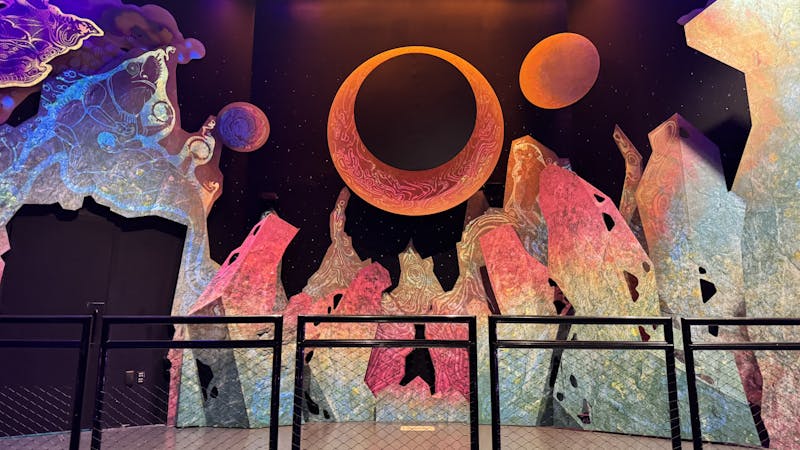Review: “A Night of Knowing Nothing” is an intimate portrait of activism

Stars: ★★★★
Rice Cinema presented three films as part of the Glorious Things series, a collaboration between Rice Cinema, Rice Humanities Research Center and FotoFest, on March 22 and 23. Organized by assistant professor of art Sindhu Thirumalaisamy, the films detail stories from the perspectives of marginalized groups that are connected by a common theme: the intensifying of authoritarianism at Indian universities. “Does Your House Have Lions?” focuses on university suppression of queer students, while “We Have Not Come Here to Die” and “A Night of Knowing Nothing” center on student protest movements that swept India after the death of Rohith Vemula, a student, activist and Dalit, the lowest ranking group in traditional Indian caste hierarchy.
Directed by Payal Kapadia, “A Night of Knowing Nothing” was the last of the three to be screened and has received the most critical acclaim of the bunch, winning the Golden Eye for Best Documentary at the 2021 Cannes Film Festival. Kapadia’s first feature-length film, it is a powerful debut that sometimes feels disjointed yet nevertheless packs an urgent punch.
The film starts with a stunning shot of people dancing at a party. Narration plays over this scene, and it becomes clear that the words we hear are letters by L, a university student, written to her lover, K. While this lively yet silent scene plays, L speaks to her beloved, expressing how even at this party, she misses him. The audience eventually comes to know that K was forced by his parents to stop seeing L, as she was of a lower caste than him. While L is initially forgiving of K, as the film goes on, she grows angry with K and his inability to stand up for their love against his parents.
This intimate story of heartbreak and betrayal is laced throughout the fabric of the story, sometimes as the center of a scene and at other times supplementing sequences of student activism. The film’s raucous protest scenes are invigorating, and as Kapadia contextualizes the institutional discrimination these students are fighting, the movie becomes a call to action. By interweaving human stories and these scenes of protest, Kapadia attempts to give these movements a human face. Under her direction, the anger of the protesters seems tangible and raw due to her emphasis on the activists’ humanity. While the film sometimes struggles with juggling the intimacy of L’s letters and the unadulterated anger of the protest scenes, Kapadia mostly succeeds in grounding a student movement in the stories of individual human experiences.
As even Rice’s administration is being criticized for what some consider to be “oversteps of power,” “A Night of Knowing Nothing” may resonate with those who believe that their institutions are suppressing student voices; it’s a film with the preoccupations of student activists at its core. It also references the cinematic tradition of protest film by including references to filmmakers who were known for the polemic political statements they imbued into their cinema, such as Jean-Luc Godard, Ritwik Ghatak and Pier Paolo Pasolini.
The film also serves as an introductory perspective into India’s student activist movements. For those unaware of movements across Indian universities fighting for the Muslim, Dalit-Bahujan castes and LGBTQ+ communities, the film is a riveting crash course. In that way, the film, even with its detailing of discrimination, authoritarianism and hate, can be a source of hope for some with its illustration of perseverance and people who will risk anything to fight for what they believe in.
“A Night of Knowing Nothing” serves as a reminder of the importance of standing up against injustice, no matter the scale and encourages viewers to reflect on their own roles in challenging oppressive systems. Kapadia’s film is an impactful testament to the power of activism and the resilience of those fighting for change. It serves as a compelling call to action for viewers, urging them to engage with and challenge the restrictive practices present in their own communities.
More from The Rice Thresher

Thresher’s guide to arts and entertainment in Houston
New to the city? Unsure how to spend your time procrastinating on homework? You’re in luck — Houston is a playground if you know where to look, and most of it is an easy metro ride or short commute from campus. Here’s a starter pack of spots that deliver fresh air, brain food and the occasional “wait, this is in Houston?” moment.

Thresher’s Lollapalooza report: Who ruled Grant Park?
Chicago’s Grant Park ran on pure dopamine this weekend — surprise debuts, late-but-worth-it arrivals, confetti, fireworks and at least three mass sing-alongs an hour. From Joey Valence & BRAE road-testing new indietronica to A$AP Rocky cracking open his vault, T-Pain turning the field into karaoke and Olivia Rodrigo summoning Weezer, Lollapalooza felt like a live-wire mixtape. Doechii built a universe, TWICE made history and Sabrina signed off with a superstar-cementing finale. Here’s what actually lived up to the skyline.
“Ginny & Georgia” Season 3: A Messy, Magnetic Villain Origin Story
I’ll admit it: I came into “Ginny & Georgia” expecting another glossy Netflix soap that looks great in a weekend binge but evaporates from memory by Monday. By the end of season three, I realized I’d been doing something I rarely do with shows like this: I was taking notes. Not on the plot (though it’s as twisty and outrageous as ever), but on the characters. I loved them. I was grinning from ear to ear watching them scheme, stumble and monologue their way through impossible situations. That’s when I knew: this show had done something right.


Please note All comments are eligible for publication by The Rice Thresher.